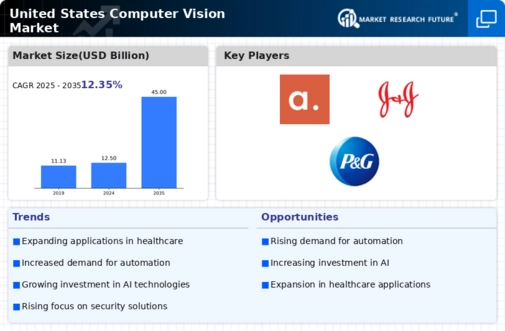Rising Demand for Automation
The push for automation across various sectors is significantly impacting the computer vision market. Industries such as manufacturing, logistics, and agriculture are increasingly adopting automated systems that rely on computer vision for tasks such as quality control, inventory management, and crop monitoring. According to recent estimates, the automation market in the US is expected to grow at a CAGR of 9.5% from 2021 to 2028, which could lead to a corresponding increase in the demand for computer vision technologies. This trend indicates that as businesses seek to enhance operational efficiency and reduce labor costs, the integration of computer vision solutions will likely become a critical component of their automation strategies, thereby propelling market growth.
Technological Advancements in AI
The computer vision market is experiencing a surge due to rapid advancements in artificial intelligence (AI) technologies. Innovations in machine learning algorithms and neural networks enhance the capabilities of computer vision systems, enabling them to process and analyze visual data with unprecedented accuracy. In the US, the AI sector is projected to reach $190 billion by 2025, indicating a robust growth trajectory that directly influences the computer vision market. As AI becomes more integrated into various applications, the demand for sophisticated computer vision solutions is likely to increase, driving market expansion. This trend suggests that companies investing in AI-driven computer vision technologies may gain a competitive edge, as they can offer more efficient and effective solutions across diverse industries.
Expansion of Smart City Initiatives
The development of smart city initiatives across the US is creating new opportunities for the computer vision market. These initiatives aim to improve urban living through the integration of technology in infrastructure, transportation, and public services. Computer vision plays a crucial role in smart city applications, such as traffic management, public safety, and environmental monitoring. As cities invest in these technologies, the computer vision market is expected to benefit from increased funding and support. Reports indicate that smart city investments in the US could exceed $100 billion by 2025, suggesting a robust growth potential for computer vision solutions that contribute to the efficiency and sustainability of urban environments.
Growth in E-commerce and Online Retail
The rapid growth of e-commerce and online retail is significantly influencing the computer vision market. As businesses seek to enhance customer experiences and streamline operations, they are increasingly adopting computer vision technologies for applications such as visual search, inventory management, and personalized marketing. The US e-commerce market is projected to surpass $1 trillion by 2025, indicating a strong demand for innovative solutions that leverage computer vision. This trend suggests that companies focusing on integrating computer vision into their e-commerce platforms may gain a competitive advantage, as they can offer more engaging and efficient shopping experiences, thereby driving further growth in the computer vision market.
Surge in Security and Surveillance Needs
The growing emphasis on security and surveillance in both public and private sectors is a key driver for the computer vision market. With increasing concerns over safety and crime prevention, organizations are investing in advanced surveillance systems that utilize computer vision for real-time monitoring and threat detection. The US security market is projected to reach $100 billion by 2025, with a significant portion allocated to technologies that incorporate computer vision capabilities. This trend suggests that as security needs evolve, the computer vision market will likely see heightened demand for innovative solutions that enhance situational awareness and response times, thereby fostering market growth.

















Leave a Comment